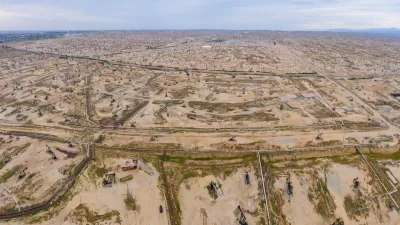According to one study, cities are often wrongly blamed for 75 to 80% of greenhouse gas emissions; the figure is closer to 40%.
"...The paper also highlights how it can be misleading to allocate greenhouse gas emissions to places. For instance, emissions from power stations should be allocated to those that consume the electricity, not the places where the power stations are located. Emissions generated by industries should likewise be allocated to the person consuming the goods the industries produce.
'Consumer demand drives the production of goods and services, and therefore the emission of greenhouse gases,' says [the paper's author, David] Satterthwaite.
'Allocating emissions to consumers rather than producers shows that the problem is not cities but a minority of the world's population with high-consumption lifestyles. A large proportion of these consumers live not in cities but in small towns and rural areas.'"
Thanks to Jon Cecil, AICP
FULL STORY: Don't Blame Cities For Climate Change, See Them As Solutions

Alabama: Trump Terminates Settlements for Black Communities Harmed By Raw Sewage
Trump deemed the landmark civil rights agreement “illegal DEI and environmental justice policy.”

Planetizen Federal Action Tracker
A weekly monitor of how Trump’s orders and actions are impacting planners and planning in America.

The 120 Year Old Tiny Home Villages That Sheltered San Francisco’s Earthquake Refugees
More than a century ago, San Francisco mobilized to house thousands of residents displaced by the 1906 earthquake. Could their strategy offer a model for the present?

Indy Neighborhood Group Builds Temporary Multi-Use Path
Community members, aided in part by funding from the city, repurposed a vehicle lane to create a protected bike and pedestrian path for the summer season.

Congestion Pricing Drops Holland Tunnel Delays by 65 Percent
New York City’s contentious tolling program has yielded improved traffic and roughly $100 million in revenue for the MTA.

In Both Crashes and Crime, Public Transportation is Far Safer than Driving
Contrary to popular assumptions, public transportation has far lower crash and crime rates than automobile travel. For safer communities, improve and encourage transit travel.
Urban Design for Planners 1: Software Tools
This six-course series explores essential urban design concepts using open source software and equips planners with the tools they need to participate fully in the urban design process.
Planning for Universal Design
Learn the tools for implementing Universal Design in planning regulations.
Clanton & Associates, Inc.
Jessamine County Fiscal Court
Institute for Housing and Urban Development Studies (IHS)
City of Grandview
Harvard GSD Executive Education
Toledo-Lucas County Plan Commissions
Salt Lake City
NYU Wagner Graduate School of Public Service





























